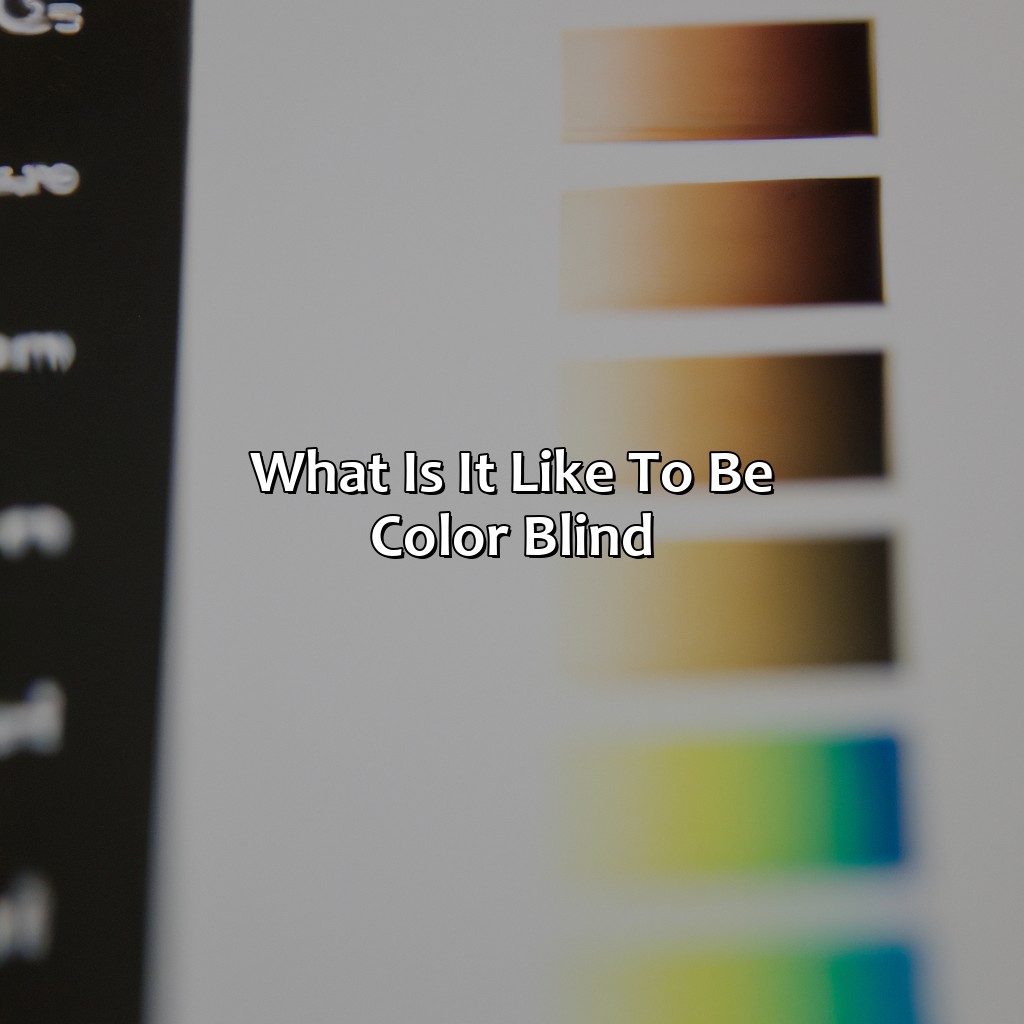Key Takeaway:
- Color blindness affects approximately 8% of men and 0.5% of women worldwide, with red-green color blindness being the most common type. It is a condition that impairs the ability to perceive and recognize certain colors accurately.
- Color blind people have difficulty distinguishing certain colors and may see colors differently than those with normal color vision. They also face challenges in daily life, such as interpreting color-coded information, participating in certain professions or hobbies, and identifying certain objects or signals.
- While there is no cure for color blindness, colorblindness glasses and other assistive devices can help color blind people see more colors and distinguish them more accurately. Raising awareness about color blindness and promoting inclusivity in society can also help color blind people feel more supported and understood.
What is color blindness?
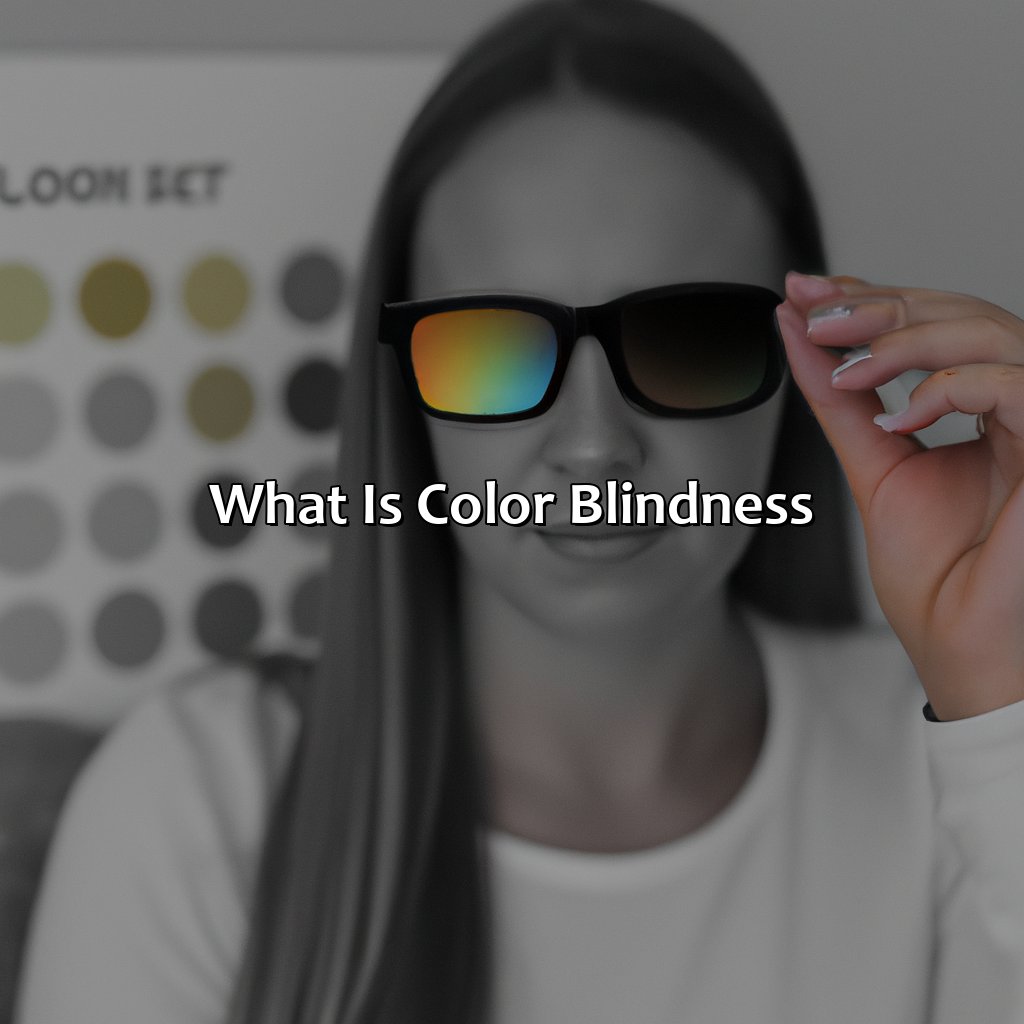
Photo Credits: colorscombo.com by Joshua Robinson
Let’s explore color blindness! It’s also known as color deficiency. It can take many forms, like achromatopsia, anomalous trichromatism, dichromatism, monochromatism, cone dystrophy, and retina disorder.
What causes color blindness? It can be inherited, acquired, genetic, or ocular. Types of color blindness include protanopia, deuteranopia, tritanopia, red-green color blindness, and blue-yellow color blindness.
Causes of color blindness
Given the nature of color blindness, its causes are varied and unique. Inherited color blindness is primarily due to a genetic mutation in the genes that control color vision. Acquired color blindness, on the other hand, occurs as a result of damage to parts of the eye that facilitate vision. Furthermore, ocular color blindness can occur due to aging processes that result in degeneration of retinal cells.
It is interesting to note that genetic color blindness affects males more than females because it is linked to the X chromosome. This means that if a woman carries one mutated gene but has a normal gene on her other X chromosome, she is unlikely to be affected by it. However, when it comes to males who possess only one X chromosome, inheriting even a single mutated gene could result in severe consequences.
Recent scientific studies have emphasized that certain environments and behaviors may increase your risk of developing acquired color-blindness. One example would be exposure to high levels of ultraviolet light from the sun which could lead to gradual macular degeneration over time.
Given that people with color-blindness face educational and professional hurdles due to their reduced capacity for accurate color discrimination; effective screening and early intervention measures need development for successful treatment outcomes.
Don’t let inherited or acquired color blindness reduce your quality of life – explore screening options today!
Why see in color when you can see in shades of gray? Learn about the different types of color blindness, from red-green to blue-yellow, and the science behind them.
Types of color blindness
Color blindness is the inability to distinguish certain colors. It is caused by genetic mutations that affect the cones in the eyes responsible for color vision. Therefore, individuals are born with this condition and it cannot be acquired later in life. The types of color blindness include protanopia (lack of red cones), deuteranopia (lack of green cones), and tritanopia (lack of blue cones). The most common type is red-green color blindness, which affects about 8% of men and 0.5% of women. On the other hand, blue-yellow color blindness is rare.
The following table provides more details on each type of color blindness:
| Type | Proportion within | Cone affected | Common characteristics |
|---|---|---|---|
| Protanopia | 1% of males | Lacking functioning red cones | Difficulty distinguishing between shades of green, yellow and red |
| Deuteranopia | 6% male, 0.4% female | Lacking functioning green cones | Difficulty distinguishing between shades of yellow and green |
| Tritanopia | Rare | Lacking functioning blue cone | Difficulty distinguishing between blue tones |
Color blind individuals face a unique challenge when it comes to perceiving the world around them differently than people with normal color vision. They may have difficulty identifying colors or misinterpret color-coded information such as maps or charts. However, some strategies can be used to cope with this condition such as memorizing different hues’ brightness or seeking assistance from those who can see colors.
A pro tip for those designing visual communication materials would be to ensure that they use different symbols or patterns on top of colors to indicate meaning so that individuals with different types of color blindness can perceive them easily.
Color blind people have a unique perspective on life; they see the world in a dull and confusing tone, like watching a movie with bad lighting.
What do color blind people see?
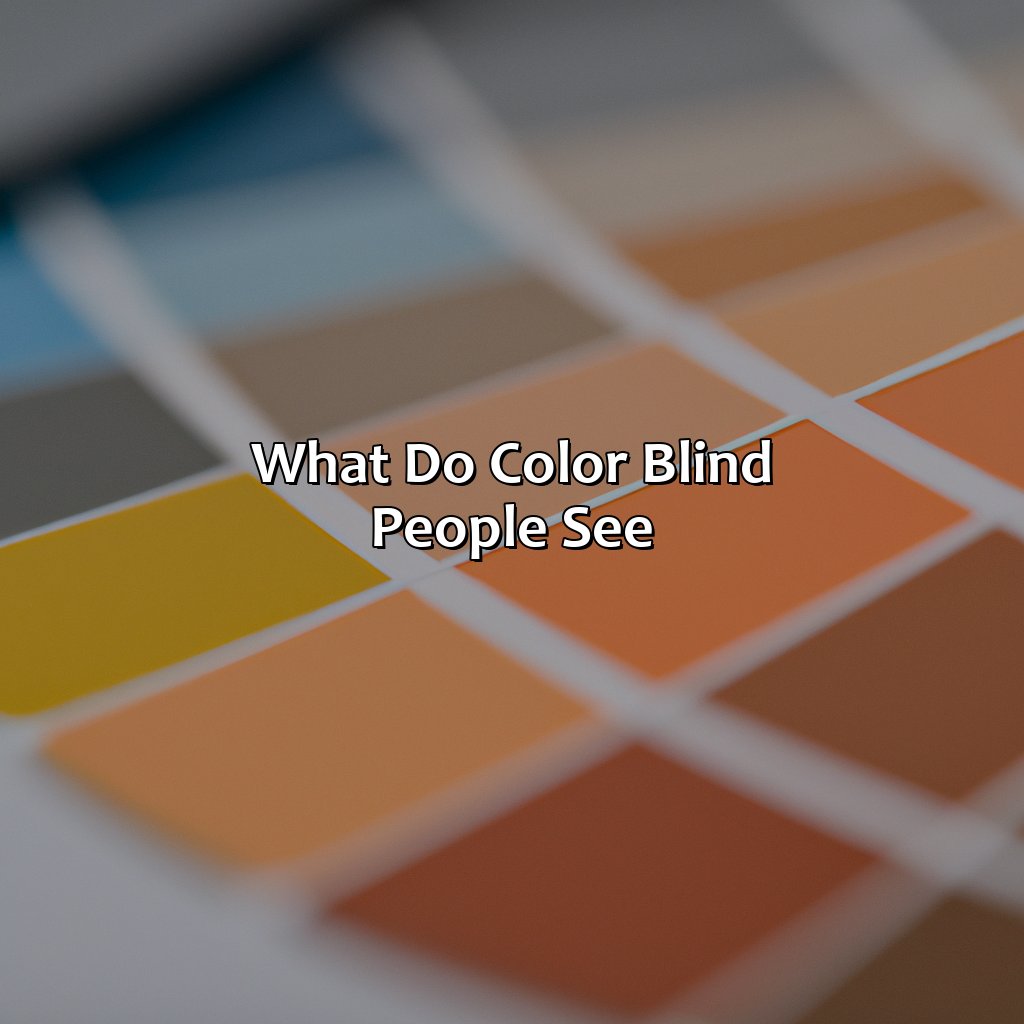
Photo Credits: colorscombo.com by Dennis Carter
To grasp the visual experiences of color blind people, you must look into their color vision deficiency. This article section will focus on that. With colorblindness and color vision simulators, you can see the world from the perspective of those with color vision impairments.
The article has two subsections:
- The first explains the difficulty color blind people have recognizing colors due to vision deficiency.
- The second covers the problems they have interpreting color-coded information. It also tells how vision tests, color vision glasses, and filters can assist.
Difficulty identifying colors
For individuals with vision deficiency, identifying colors on the color spectrum can be a challenging task. The lack or reduced presence of certain cone cells in the retina causes this condition, which is called colorblindness.
Colorblindness types can vary from person to person, with different levels of intensity and hues impacted. Prevalence rates vary geographically but statistics report that 8% of males and about 0.5% of females experience some form of color blindness.
Such individuals face difficulties distinguishing between similar-looking colors such as red-green or blue-yellow, which can cause confusion when interpreting traffic signals or colored graphs. This can lead to misinterpretation of color-coded information in areas such as map reading and navigating websites.
To overcome these challenges faced by color blind people, there are several strategies they can use. For example, using patterns or shapes instead of relying solely on colors helps communicate information that’s visually distinguishable for someone with vision deficiency. Creating labels with text in addition to color-coding also assists understanding.
By adopting these practical steps, one’s efforts towards creating an inclusive society will pave the way for better identification and support for individuals facing visual impairment caused by conditions such as color blindness.
Color blind? More like color confused when it comes to deciphering those pesky color-coded diagrams and vision tests.
Misinterpreting color-coded information
Misinterpreting Color-coded Information
Individuals with color blindness face daily challenges, one of which includes misinterpretation of color-coded information. This can occur in various settings such as traffic signals, charts, graphs, and maps. The severity varies depending on the type of color blindness a person has.
For instance, individuals with protanomaly or deuteranomaly struggle to differentiate between red and green hues which can lead to confusion in interpreting data that relies on these colors. Meanwhile, those with tritanomaly face difficulty differentiating blue and yellow hues which might lead to interpretation mistakes in printed texts.
Moreover, it is important to note that misinterpreting color-coded information can have serious consequences in certain situations such as aviation or transportation industries where accurate color recognition is crucial for safety measures. Therefore, people diagnosed with color blindness should take a comprehensive vision test like Ishihara test or Farnsworth-Munsell 100 Hue Test to evaluate their condition. Once diagnosed, they may consider using assistive tools such as pseudoisochromatic plates for determining colors or wearing special glasses such as Full-spectrum light or red/green/blue filters that alter spectral content to help detect colors more accurately. With this proactive approach and proper support, they can overcome the difficulties associated with color blindness and enjoy a fulfilling life.
Living with color blindness: where adjusting to a world of ‘What color is that?’ is a daily struggle, but finding support in the colorblind community makes all the difference.
Living with color blindness
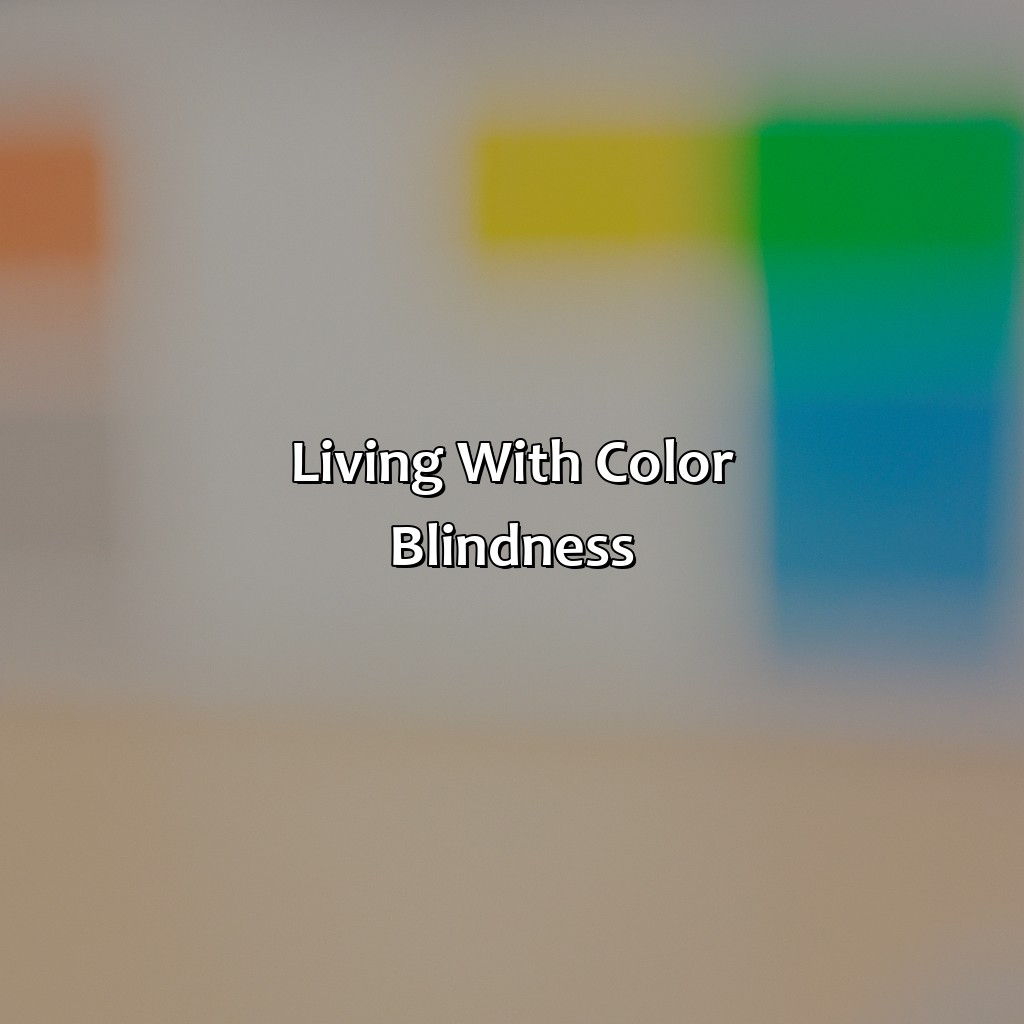
Photo Credits: colorscombo.com by Benjamin White
Living with a vision disability like color blindness requires building awareness and community support. We’ll explore the colorblindness experiences, challenges of perceiving and recognizing colors. Also, you’ll find strategies for managing color blindness with effective coping mechanisms.
Challenges in everyday life
Everyday difficulties faced by individuals with color blindness include limitations in perceiving and recognizing colors, which often results in an inability to participate fully in activities that rely on color perception. This impacts facets such as driving, cooking, graphic design, and art. Furthermore, some colorblind individuals report feeling anxious or left out when partaking in group events based on color recognition.
Colorblindness Effects extend beyond a lack of visual understanding of the environment. A human’s interaction with its ecosystem is connected to how one perceives it – from social cues like traffic lights and signs to identifying ripeness in fruits or burning oven-on indicators. These are everyday challenges that immerses individuals who do not have a “normal” sense of color perception.
Color recognition plays a crucial role in visually acquiring information from conventional media like charts and graphs or traffic signals securely. It may cause confusion or misinformation leading to mistakes resulting in potential accidents. The colored-centric world puts an individual with vision deficiency at risk.
To truly understand the impact of living with such a deficiency, one must put themselves within their shoes- both figuratively and literally as this condition can result in safety hazards while performing tasks throughout daily life.
Thus, creating awareness regarding the struggles people experience due to colorblindness could help other individuals adapt better to their needs and provide an inclusive environment for all persons with different forms of vision issues.
Colorblindness management: when in doubt, ask for help and hope your friends aren’t playing a prank on you.
Strategies for coping with color blindness
Individuals with color blindness often face challenges in their daily life while dealing with colors. Therefore, there are various techniques and approaches available for colorblindness management that can assist them in better coping with this condition. Different color codes and patterns make it easier to recognize colors. The use of software or apps is also useful for individuals seeking additional assistance.
There are many tools that can help people adjust to the workplace or educational setting, such as screen-reading programs or certain applications that highlight text based on its importance. Additionally, opting for different lenses available in eyeglasses enhances the color perception capabilities of those who are dealing with color blindness.
A significant aspect of colorblindness management is also related to creating an accessible environment by understanding the needs of the person. Non-color-coded options, labeling items with textual descriptions instead of solely relying on color coding, and using high-contrast visual aids could make a huge difference for individuals struggling with this condition.
It can be overwhelming to navigate a world that heavily relies on vibrant shades-based signifiers without being able to perceive their effect accurately upon interaction. Seeking support from professionals and raising awareness about the challenges faced by people living with this condition helps communities become more compassionate and aware.
Detecting color blindness is more than just seeing red flags – symptoms can range from mild to severe, and diagnosis is crucial for effective treatment.
Diagnosing and treating color blindness
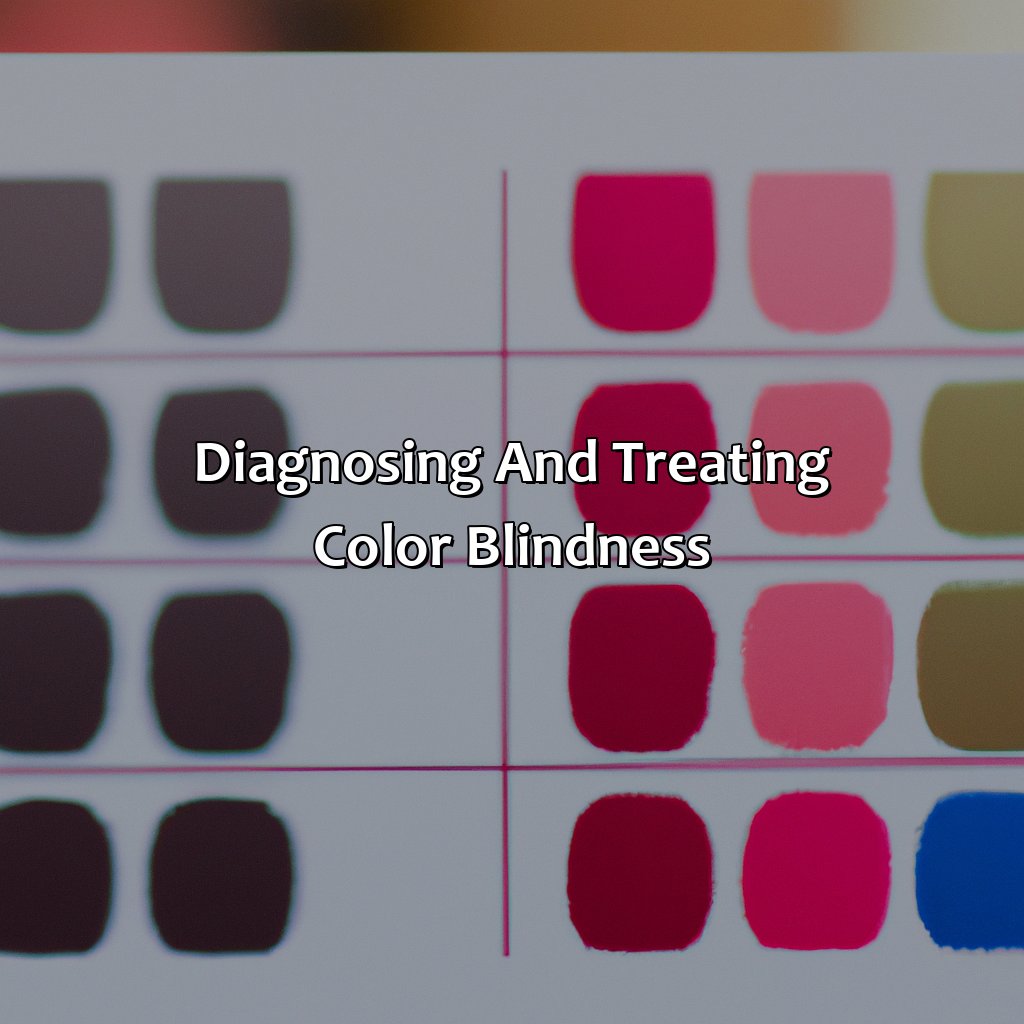
Photo Credits: colorscombo.com by Albert Lewis
Diagnosing and treating color blindness requires quick solutions. To understand it properly, you must know how it is diagnosed. Vision tests and color vision tests such as Ishihara and Farnsworth-Munsell 100 Hue are used by healthcare professionals. Treatment options include colorblindness glasses and retina-related treatments.
How color blindness is diagnosed
Diagnosing Color Blindness
To identify color blindness, a vision test is conducted by optometrists or ophthalmologists. The colors and pattern tests are commonly used to diagnose the different types of color blindness. Ishihara test plates or pseudoisochromatic plates that depict numbers hidden in varying-colored dots are most frequently utilized. Furthermore, the Farnsworth-Munsell 100 Hue Test is another standard procedure for diagnosing color blindness as it assesses a patient’s ability to perceive subtle color variations.
Experts utilize other techniques such as lantern tests or spectral photometry to determine whether someone has deuteranopia, protanopia, or tritanopia, which are rare types of color dysfunction. In addition to these exams, a comprehensive eye exam including visual acuity testing may also be performed.
In some cases, patients must take several tests at various intervals before receiving an official diagnosis. Fortunately, several online resources provide self-screening tools to help persons with suspected colorblindness better understand their symptoms before meeting with an optometrist for confirmation.
A close friend thought the inability to decipher traffic lights was just carelessness until she visited an eye clinic. They diagnosed her with protanopia and explained it was genetic. She embraced the recommended strategies by writing down the hues matched with popular items and asking friends to double-check her clothing choices before leaving home.
Seeing the world in Technicolor is now within reach with colorblindness glasses, a must-have accessory for those with retina disorders.
Treatment options
Color Blindness Treatment Strategies and Options
Correcting color blindness is not currently possible, but certain tools and techniques can help manage the effects of the condition. Colorblindness glasses or color vision glasses are a promising new treatment that works by enhancing the contrast between colors to help people better distinguish them. Some people with retinal disorders can also benefit from special lenses that adjust the wavelengths of light entering the eye.
It’s also crucial for educators and employers to take steps to make materials accessible for those with color blindness. This includes avoiding relying solely on color-coded information and using other visual cues, like symbols or patterns, to help convey important messages.
Pro Tip: Don’t assume what colors look like to someone with color blindness. Instead, ask them how they see things and try to accommodate their unique perspective as much as possible.
Five Facts About Color Blindness:
- ✅ Color blindness is a genetic condition affecting a significant proportion of the population, with approximately 8% of men and 0.5% of women being color blind. (Source: Colour Blind Awareness)
- ✅ Color blindness results from a lack of or abnormal functioning of the specialized photopigments in the cone cells of the retina that are responsible for color vision. (Source: National Eye Institute)
- ✅ There are different types of color blindness, including protanopia, deuteranopia, and tritanopia, which affect the perception of red-green, green-red, and blue-yellow colors, respectively. (Source: American Academy of Ophthalmology)
- ✅ Color blindness can affect a person’s ability to perform certain tasks, such as reading color-coded information or distinguishing between certain colors in art or nature. (Source: NCBI)
- ✅ While there is currently no cure for color blindness, there are some accommodations and technologies that can help color-blind individuals navigate their daily lives, such as color filters, special glasses, and smartphone apps. (Source: Color Blind Awareness)
FAQs about What Is It Like To Be Color Blind
What is it like to be color blind?
Color blindness, also known as color vision deficiency, is a condition where people have difficulty distinguishing certain colors. This means that they see colors differently than most people do.
What causes color blindness?
Color blindness is usually an inherited condition caused by abnormalities in the photopigments found in the cones of the retina. However, it can also be caused by some diseases, medications, and eye injuries.
Are there different types of color blindness?
Yes, there are different types of color blindness, each with varying degrees of severity. The most common type is red-green color blindness, which means that people have difficulty distinguishing between red and green. Other types include blue-yellow color blindness and total color blindness.
Is color blindness a serious condition?
Color blindness is not usually a serious condition and does not affect a person’s overall health. However, it can affect everyday activities, such as driving and choosing clothing that matches.
Can color blindness be treated?
There is no cure for color blindness, but there are special glasses and contact lenses that can help people with red-green color blindness distinguish colors more accurately. However, these are not effective in all cases and can be quite expensive.
How can I support someone who is color blind?
If you know someone who is color blind, be patient with them and try to understand the challenges that they may face. Avoid using color to convey important information and try to provide context where possible.
